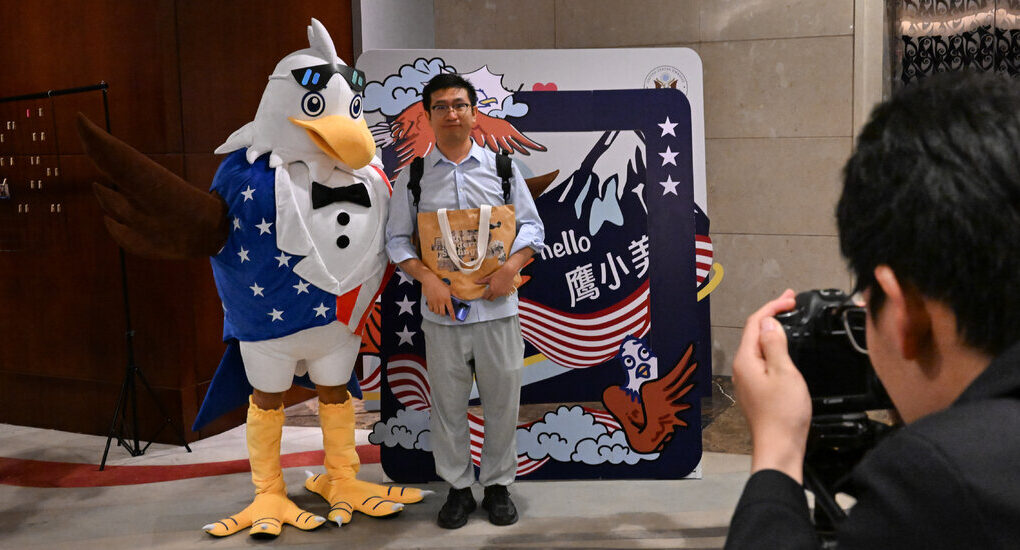On a cool Saturday morning, in a hotel basement in Beijing, throngs of young Chinese gathered to do what millions had done before them: dream of an American education.
At a college fair organized by the United States Embassy, the students and their parents hovered over rows of booths advertising American universities. As a mascot of a bald eagle worked the crowd, they posed eagerly for photos.
But beneath the festive atmosphere thrummed a note of anxiety. Did America still want Chinese students? And were Chinese students sure they wanted to go to America?
“We see the negative news, so it’s better to be careful,” said Zhuang Tao, the father of a college senior considering graduate school in the United States, Australia and Britain. He had read the frequent headlines about gun violence, anti-Asian discrimination and, of course, tensions between the United States and China, at one of their highest levels in decades. “After all, the entire situation is a bit complicated.”
Students have been traveling between China and the United States for generations, propelled by ambition, curiosity and a belief that their time abroad could help them better their and their countries’ futures. The first Chinese student to graduate from an American university, Yung Wing, arrived at Yale in 1850 and later helped send 120 more students to America.
The trickle became a steady stream: For nearly the past two decades, Chinese students have made up the largest share of international students in the United States. And for Americans, until the coronavirus pandemic, China was the most popular destination for study abroad outside of Western Europe, according to an annual State Department-funded survey. Students have been an anchor in the two countries’ relations, even when political or economic ties have soured.
But that anchor is now under threat. For the last three years, the number of Chinese students in the United States has fallen, according to the State Department survey. The number of American students in China, meanwhile, plummeted during the pandemic to a mere 350 as of this year, the American Embassy has said, compared to more than 11,000 in 2019.
Both Beijing and Washington have acknowledged the importance of restoring exchanges. During his trip to San Francisco this month, China’s leader, Xi Jinping, declared that China was “ready to invite” 50,000 Americans to study in China over the next five years. The American ambassador to China, Nicholas Burns, has insisted that the United States welcomes Chinese students.
But the official rhetoric belies obstacles that both governments have continued to erect, driven by the same nationalism and concerns about national security that have derailed other parts of the relationship. Chinese propaganda regularly depicts the United States as dangerously crime-ridden, and many Chinese are also worried by increased reports of visa denials or border interrogations in the U.S. upon arrival.
For Americans, the appeal of visiting China has dimmed under Mr. Xi, an authoritarian leader who has stoked anti-foreign sentiment. The U.S. government has also prohibited some American students from studying there, and some language-learning programs that it funds have moved from mainland China to Taiwan.
Scholarly collaborations at all levels have been eroded by the geopolitical tensions. But a reduction in student exchanges could be especially harmful to the future of understanding between the two countries, said Denis Simon, the former executive vice chancellor of Duke Kunshan University, a partnership between Duke University and Wuhan University in eastern China.
Americans “need to have a generation of young people who are our future China watchers,” Mr. Simon said. “You can only get that from spending time on the ground.”
His concerns run the other way, too: “And it worries me that we may not be helping the Chinese understand us.”
Chinese university students are still a robust presence in the United States, with nearly 290,000 in the 2022-23 school year. But many Chinese are concerned about programs like the Justice Department’s now-scrapped China Initiative, which critics said discriminated against scientists of Chinese descent.
Other students have had visas revoked or denied under a Trump-era order, upheld by the Biden administration, that bans students from certain Chinese universities from graduate study in the United States. Washington says those universities — the list is not public — have ties to China’s military.
That order, known as Proclamation 10043, is the reason Xi Chen, a doctoral student in the United States who researches transportation innovations such as self-driving cars, is stranded in China, thousands of miles from her research lab and her belongings.
Ms. Chen had arrived in the United States in 2018, before the proclamation was enacted. Earlier this year, she returned to China to visit her family after China lifted Covid restrictions and reopened its borders. But when she tried to go back to the United States, her application for a new visa at the embassy in Beijing was rejected.
The embassy cited the proclamation, which she said she had heard little about, indicating that Beijing’s Beihang University, a leader in China’s aviation and space research, and where Ms. Chen had completed her undergraduate studies, was blacklisted.
“I’ve always looked up to the United States. It provides the best opportunities for highly skilled engineers,” said Ms. Chen, who had previously hoped to work in the United States after graduating. But now she is unsure. “It’s not as bright as I thought. I think it’s very divided.”
American officials have defended the proclamation as crucial to protecting national security, and said that the number of visas denied or revoked is tiny — about 3,000 between 2020 and 2021, the last years for which data is available — compared to the greater pool of Chinese students in the United States. About 94,000 Chinese have received visas to study in the United States this year, an increase of 28,000 from last year, according to the American Embassy. (Nearly 108,000 such visas were issued in fiscal year 2019, according to State Department data.)
But some politicians have suggested widening bans on Chinese students, and in some polls, a majority of Americans backed limiting Chinese students.
By making Chinese students feel unwelcome, the United States is hurting one of its historic strengths, said Hung Huang, who, as a 12-year-old in the 1970s, was one of the first students the Communist government sent to the United States.
“The Chinese have flocked to America all these years, because they feel that that particular freedom and tolerance will allow them to flourish,” said Ms. Hung, now a prominent media mogul and writer. “The problem is that somehow Americans have figured out, to win this battle in their mind against China, they need to be authoritarian also.”
The flow of Americans to China has always been much smaller. But Washington recognized the importance of increasing it. In 2010, President Barack Obama launched an initiative to send 100,000 American students to China over five years, who the State Department said would be “the next generation of American experts on China.”
In recent years, though, many foreigners have grown wary of China. China’s Ministry of State Security, which oversees its secret police, this summer called for a “whole of society mobilization” against suspected foreign spies. Under Mr. Xi, restrictions on academic freedom have threatened to extend to foreign-run campuses in China, with some administrators emphasizing the importance of the Communist Party.
Washington’s enthusiasm about sending students to China has also waned. In 2019, the Schwarzman Scholars, a fellowship that brings many Americans to Tsinghua University in Beijing for master’s degrees, was told by the Army, Navy and Air Force academies that cadets there would no longer be able to participate, because of a new Defense Department directive limiting engagement with China. The Schwarzman program has lobbied to have the directive reversed, as “having military leaders with exposure to China is important,” Leanna Yip, the program’s chief marketing officer, said in an email.
The Defense Department had no immediate comment.
The Biden administration has also not reinstated the Fulbright program in China, which President Donald J. Trump suspended. And some American universities have relocated their Mandarin-learning programs to Taiwan, including Harvard and several public institutions whose Chinese programs receive Defense Department funding.
Mr. Simon, the former Duke Kunshan administrator, said concerns about cybersecurity or intellectual property theft in U.S.-China academic collaborations were valid. But he was troubled by the reluctance of American universities to allow students to even visit China.
The University of North Carolina at Chapel Hill, which Mr. Simon joined in January after leaving Duke, does not allow study abroad programs to China, because of the State Department’s Level 3 travel advisory for the country, which warns of the possibility of arbitrary detention. Washington upgraded China from its previous Level 2 warning, out of 4, in 2020.
Mr. Simon resigned in August, criticizing what he called the university’s reluctance to engage with China and train future experts. “We’re going to play catch-up, to our detriment, unless we act really quickly,” he said.
Joy Dong and Siyi Zhao contributed research from Hong Kong and Seoul.



